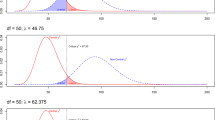Abstract
This paper first reduces the problem of detecting structural breaks in a random walk to that of finding the best subset of explanatory variables in a regression model and then tailors various subset selection criteria to this specific problem. Of particular interest are those new criteria, which are obtained by means of simulation using the efficient algorithm of Bai and Perron (J Appl Econom 18:1–22, 2003). Unlike conventional variable selection methods, which penalize new variables entering a model either in the same way (e.g., AIC and BIC) or milder (e.g., MRIC and \(\mathrm {FPE}_\mathrm{{sub}}\)) than already included variables, they do not follow any monotonic penalizing scheme. In general, their non-monotonicity is more pronounced in the case of fat tails. The characteristics of the different criteria are illustrated using bootstrap samples from the Nile data set.



Similar content being viewed by others
References
Akaike H (1969) Fitting autoregressive models for prediction. Ann Inst Stat Math 21:243–247
Akaike H (1973) Information theory and an extension of the maximum likeliihood principle. In: Petrov BN, Csaki F (eds) Second international symposium on information theory. Akademia Kiado, Budapest, pp 267–281
Bai J, Perron P (1998) Estimating and testing linear models with multiple structural changes. Econometrica 66:47–78
Bai J, Perron P (2003) Computation and analysis of multiple structural change models. J Appl Econom 18:1–22
Bai J, Perron P (2006) Multiple structural change models: a simulation analysis. In: Corbea D, Durlauf S, Hansen BE (eds) Econometric theory and practice: frontiers of analysis and applied research. Cambridge University Press, Cambridge, pp 212–237
Cobb GW (1978) The problem of the nile: conditional solution to a changepoint problem. Biometrika 65:243–251
Foster DP, George EI (1994) The risk inflation criterion for multiple regression. Ann Stat 22:1947–1975
George EI, Foster DP (2000) Calibration and empirical Bayes variable selection. Biometrika 87:731–747
Hong H, Preston B (2012) Bayesian averaging, prediction and nonnested model selection. J Econom 167:358–369
Kabaila P (2002) On variable selection in linear regression. Econom Theory 18:913–925
Kass RE, Wasserman L (1995) A reference Bayesian test for nested hypotheses and its relationship to the Schwarz criterion. J Am Stat Assoc 90:928–934
Kempthorne PJ (1984) Admissible variable-selection procedures when fitting regression models by least squares for prediction. Biometrika 71:593–597
Kuehn C (2001) An estimator of the number of change points based on a weak invariance principle. Stat Probab Lett 51:189–196
Liu J, Wu S, Zidek JV (1997) On segmented multivariate regression. Statistica Sinica 7:497–526
Liu W, Yang Y (2011) Parametric or nonparametric? A parametericness index for model selection. Ann Stat 39:2074–2102
Ninomiya Y (2005) Information criterion for Gaussian change-point model. Stat Probab Lett 72:237–247
Perron P (1997) L’estimation de modeles avec changements structurels multiples. Actual Econ 73:457–505
R Development Core Team (2011) R: a language and environment for statistical computing. Vienna: R Foundation for Statistical Computing, ISBN 3-900051-07-0, http://www.R-project.org/
Reschenhofer E (1996) Approximating the Bayes factor. Stat Probab Lett 30:241–245
Reschenhofer E (2004) On subset selection and beyond. Adv Appl Stat 4:265–286
Reschenhofer E, Schilde M, Oberecker E, Payr E, Tandogan HT, Wakolbinger LM (2012) Identifying the determinants of foreign direct investment: a data-specic model selection approach. Stat Pap 53:739–752
Rothman D (1968) Letter to the editor. Technometrics 10:432
Schwarz G (1978) Estimating the dimension of a model. Ann Stat 6:461–464
Shibata R (1980) Asymptotically efficient selection of the order of the model for estimating parameters of a linear process. Ann Stat 8:147–164
Shibata R (1981) An optimal selection of regression variables. Biometrika 68:45–54
Sin C-Y, White H (1996) Information criteria for selecting possibly misspecified parametric models. J Econom 71:207–225
Yang Y (2005) Can the strengths of AIC and BIC be shared? A conflict between model identification and regression estimation. Biometrika 92:937–950
Yang Y (2006) Prediction/estimation with simple linear models: is it really that simple? Econom Theory 23:1–36
Yao Y-C (1988) Estimating the number of change-points via Schwarz’ criterion. Stat Probab Lett 6:181–189
Yao Y-C, Au ST (1989) Least-squares estimation of a step function. Sankhya Indian J Stat Ser A 51:370–381
Zeileis A, Kleiber C, Krämer W, Hornik K (2003) Testing and dating of structural changes in practice. Comput Stat Data Anal 44:109–123
Zeileis A, Shahb A, Patnaik I (2010) Testing, monitoring, and dating structural changes in exchange rate rregimes. Comput Stat Data Anal 54:1696–1706
Acknowledgments
The authors very much appreciate the referee’s comments, which helped to substantially improve this paper.
Author information
Authors and Affiliations
Corresponding author
Rights and permissions
About this article
Cite this article
Reschenhofer, E., Preinerstorfer, D. & Steinberger, L. Non-monotonic penalizing for the number of structural breaks. Comput Stat 28, 2585–2598 (2013). https://doi.org/10.1007/s00180-013-0419-4
Received:
Accepted:
Published:
Issue Date:
DOI: https://doi.org/10.1007/s00180-013-0419-4




